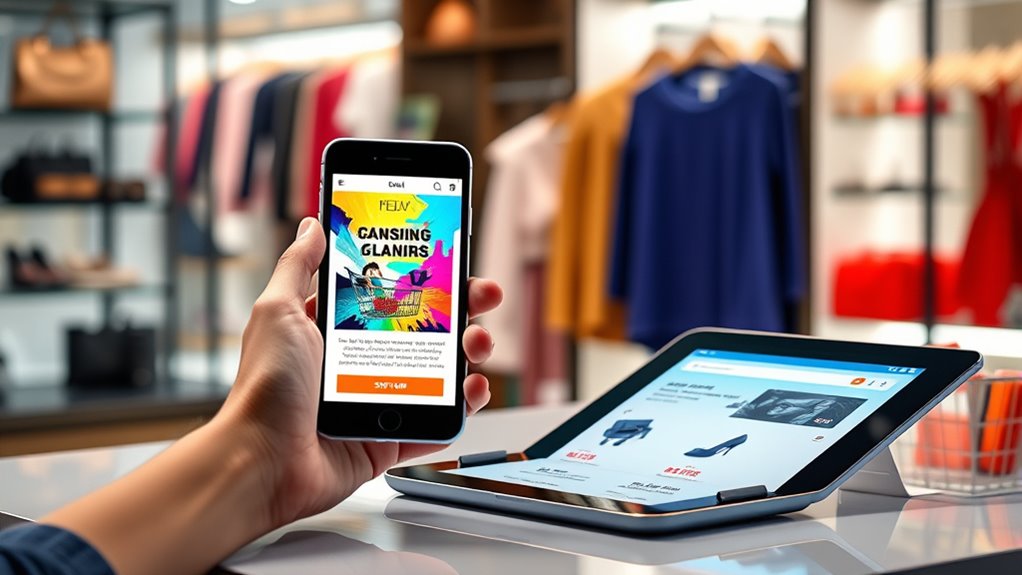To boost both in-store and online sales, focus on personalized email campaigns that highlight seasonal offers, loyalty rewards, and targeted segments. Use timely promotions like holiday discounts or special loyalty points to encourage quick action. Incorporate exclusive deals for loyal customers to deepen relationships and motivate visits or online shopping. By blending these tactics, your email marketing becomes a powerful tool. Keep exploring these strategies further to release even greater sales potential.
Key Takeaways
- Use personalized, targeted emails to highlight both in-store and online promotions, encouraging customer visits and purchases.
- Incorporate loyalty rewards and exclusive offers to motivate repeat shopping and increase engagement across channels.
- Leverage seasonal campaigns with timely discounts and themed messaging to drive immediate in-store and online sales.
- Segment audiences based on behavior and preferences to deliver relevant content that boosts open rates and conversions.
- Combine seasonal promotions with loyalty incentives to enhance overall campaign effectiveness and foster brand loyalty.

Have you ever wondered how retailers turn email campaigns into powerful tools for driving sales? It all starts with understanding how to craft messages that resonate with your audience and encourage action. Loyalty programs are a key element in this strategy. When you incorporate loyalty rewards into your emails, you make your customers feel valued, which boosts their engagement and encourages repeat purchases. For example, sending personalized offers based on their purchase history or points earned can motivate customers to visit your store or shop online more frequently. These targeted emails reinforce your loyalty program’s benefits and create a sense of exclusivity, making customers more likely to open and act on your messages.
Incorporating loyalty rewards into emails boosts engagement and encourages repeat purchases.
Seasonal campaigns also play a significant role in elevating your email marketing efforts. As the seasons change, you have a perfect opportunity to connect with your audience through timely promotions and themed messaging. Whether it’s back-to-school sales, holiday discounts, or summer clearance events, seasonal campaigns add relevance and urgency to your emails. You can craft compelling subject lines like “Summer Sale – Up to 50% Off!” or “Holiday Gift Guide Inside” to grab attention right away. When you align your email content with upcoming holidays or seasonal trends, you tap into your customers’ shopping mindset, encouraging them to act quickly before deals end. Seasonal campaigns also allow you to refresh your creative assets, keeping your emails visually appealing and engaging.
Incorporating loyalty programs into your seasonal campaigns can multiply their effectiveness. For example, during holiday seasons, you might offer double points or exclusive discounts to members of your loyalty program. This not only incentivizes immediate purchases but also deepens the relationship with your customers. When you send out these targeted emails, make sure they highlight the benefits of your loyalty program alongside the seasonal offers. This way, you remind customers of the value they’re getting, which can boost sign-ups and participation in your program.
To maximize results, you should also segment your email list based on customer behavior and preferences. For instance, loyal customers who frequently shop online might receive early access to seasonal sales, while new subscribers could get introductory offers. By tailoring your messaging, you make each email more relevant, increasing open rates, click-throughs, and ultimately, sales. Remember, the goal is to create a seamless experience where your emails serve as a bridge between your brand and your customers’ needs, whether through loyalty rewards or seasonal promotions. Additionally, understanding the legal process of divorce can help you better manage emotional and legal considerations during challenging times, ensuring a smoother transition as you rebuild your life. When executed well, these strategies work together to turn email marketing into a powerful driver of both in-store and online sales.
Frequently Asked Questions
How Can I Personalize Email Content Effectively?
To personalize email content effectively, you should use personalization strategies like segmenting your audience based on their purchase history and preferences. Tailor your messages to match the customer journey, addressing their specific needs and interests at each stage. Use dynamic content to show relevant products or offers, making your emails more engaging. This approach helps build stronger connections, increases open rates, and boosts conversions both online and in-store.
What Are the Best Times to Send Retail Emails?
You should send retail emails during peak customer engagement times, typically mid-morning and early evening on weekdays, when your audience is most receptive. Timing strategies like testing different days and hours help identify what works best. By sending emails at ideal times, you increase open rates and drive both in-store and online sales, ensuring your message reaches customers when they’re most likely to act.
How Do I Segment My Email List for Better Results?
To segment your email list effectively, start by analyzing customer preferences and purchase history. Group customers based on their interests, buying frequency, and past purchases. Use this data to tailor messages that resonate with each segment, increasing engagement. For example, send personalized offers to frequent buyers and special promotions to those interested in specific products. This targeted approach boosts your chances of driving both in-store and online sales.
What Email Metrics Indicate Successful Campaigns?
You should look at metrics like open rate, click-through rate, and conversion rate to gauge your campaign’s success. High open rates indicate strong customer engagement, while click-through rates show your email design effectively encourages interaction. Conversion rate reveals how many recipients take the desired action. Monitoring these metrics helps you refine your email design and targeting, ensuring your campaigns resonate and drive both in-store and online sales.
How Can I Avoid Spam Filters and Improve Deliverability?
You can avoid spam filters and boost deliverability by implementing email authentication like SPF, DKIM, and DMARC, which verify your identity with recipients. Additionally, regularly managing bounces helps maintain a clean list, reducing the chance of being flagged as spam. Investigating whether these measures really improve deliverability shows they’re effective; combined, they make sure your emails reach your audience and stay out of spam folders.
Conclusion
In retail email marketing, you have the power to boost both in-store and online sales effectively. Did you know that personalized emails generate 6 times higher transaction rates? By tailoring your messages and engaging customers through targeted campaigns, you can profoundly increase your revenue. Start optimizing your email strategies today, and watch your sales grow—both online and on the shop floor. Your next big sale could be just an email away!
Natali – Editor in Chief (Strategy and Mastery, AI Expert) Natali, our Editor in Chief, is the driving force behind our content’s strategic direction. With a keen eye for detail and a deep understanding of market trends, Natali ensures that our content is top-notch and strategically aligned with our client’s goals. Her expertise in AI helps to seamlessly integrate advanced technology into our marketing strategies, pushing the boundaries of conventional marketing.










